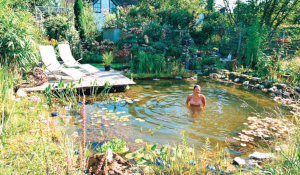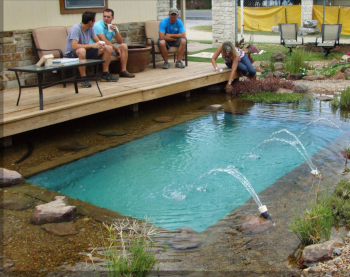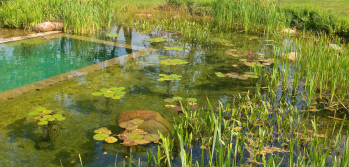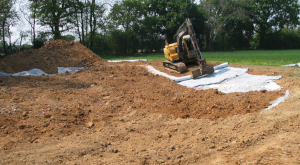Natural Swimming Pools & Ponds
I. What is a natural swimming pond?
They look like this - click on image for a bigger picture:
Natural pools that can turn an ugly garden into a unique oasis of water and vegetation and provide a pond where the swimming and vegetation zones are entirely seperate.
You can have one of these "natural swimming ponds" this one is near the house with a deck:-
This is the type that we prefer where the plant and swimmingzones are clearly separated. The wall around the swimming zone can be brought up so that it is higher than the water level to make sure that you are not swimming with the local aquatic life!
The pools all have a regeneration zone - a designated area for aquatic plants and rocks that act as natural filters to keep the water crystal clear and clean. This area adds beauty while doing all the hard work! It looks natural because it is natural. And like most things natural, it has the capacity and ability to pretty much look after itself!
It takes relaxation to a new level. A natural pool takes you closer to nature. It creates a peaceful atmosphere that disconnects you from the outside world. Aside from just plain old swimming you also get to enjoy the unique scenery that only natural swimming ponds can create.
The swimming areas of ponds are generally surrounded by shallow water that gradually increases in depth – so that they can be safer than vertical sided swimming pools as well.
Chemical-free maintenance is done by pumping the water to a series of biological filters consisting of rocks and aquatic plants. The plants deprive algae of nutrients preventing its growth. Friendly bacteria attach to the rocks and further filter the water of its impurities. And lastly – but optionally, a waterfall can add stunning visual appeal while super-oxygenating the water.
II. The Drawback
There is always a drawback to something that appears so attractive.
With natural ponds the drawback is that they are only safe for single family bathing. Any pathogens released into the pool water by a bather can be there for hours / days before the natural processes kill them off.
They may also be unsafe during extended periods of hot weather when they can suffer from algae blooms and these may persist for a long time because it is not possible to use chlorine to kill it as the water plants will also die - see below for more information on this.
So don't even think about pool parties if you have a natural pool!
III. Design & Construction
What is involved in the Design and Construction of Natural Swimming Ponds? The short answer to this question is Not a Lot!!
There is an extraordinary amount of cock and bull being peddled by a few landscaping companies that build these pools – apparently to justify the sky high prices that they charge to build them.
Will Witt first became involved in natural ponds a few years ago when he was installing pools in France and built 3 natural pool for a natural pool specialist as a sub-contractor.
It is very apparent that most if not all of these firms are run by non-qualified people that do not have any civil engineering qualifications but charge massive amounts of money for ponds that should be a lot cheaper to build than conventional chlorinated pools.
They are just ponds – that is it - PONDS!!!
A pond is a depression in the ground that is sealed so that the rainwater cannot drain away into the subsoil.
So any depression in clay subsoil will turn into a pond because the rainwater cannot drain out of it.
A depression in gravel will not become a pond because the rainwater will drain down into the gravel unless the groundwater level in the gravel sub-soil is above the bottom of the depression.
So in gravel sub-soil areas an artificial pond-liner will be required to keep the water in the pond.
The planting is important but there are specialist aquatic plant companies that have all the expertise and experience and they provide this freely if you buy the plants from them.
There is one caveat with natural swimming ponds – during a very long hot spell of weather of several weeks or more the water temperature may get so high that it may not be safe for swimming in the later weeks of the hot period.
This will be apparent because the water becomes cloudy – possibly with algae blooms. The risk of this problem occurring can be reduced by installing a water circulation system and a sand filter that will only need to be run occasionally.
Such ponds can be created by the conversion of an old concrete swimming pool or by the construction of an entirely new pond.
Conversion of old concrete pools
This conversion can bring and old neglected, unwanted, ugly pool back into vibrant life like this:-
A swimming pool ends up unwanted because nobody uses it any more but the owner will still be obliged to spend, time, effort, and money maintaining it.
You can bring these unwanted pools back to life by converting them to natural swimming ponds. The only thing it requires is a regeneration zone that needs to be built around the old pool tank.
It is possible to turn the existing concrete pool into a natural swimming pond by cutting the tops of the existing pool walls down by about 500mm and extending the pool area so that it is about double the area of the original pool and often takes up most of the grass area that surrounded the old pool.
The whole floor of the pool would then be lined with a thick pvc or butyl rubber liner and the shallow area planted with the required water plants.
The existing pump and filter can often be retained to help keep the water crystal clear - but the expense and bother of chlorination would be avoided and the area would be a nice peaceful oasis in the summer - even when if it is too cold to swim.
And the water can be heated to a certain level without damaging the plants and this would extend the swimming season to 5 or 6 months a year.
It is also normally possible to provide a jetty out across the swimming area for access to and egress from the pool. The safety aspects would have to be considered in detail but the deep areas could be delineated above the pond surface and the deep areas would all be surrounded by very shallow planted zones.
It is difficult to provide very precise budget costs for this type of pool in general as costs depend on the pool water area and volume and the design layout but a quite spectacular natural pool could be created from a relatively small existing concrete pool for a cost between £20,000 and £30,000.
New Natural Swimming Ponds
The civil engineering of these ponds involves excavation, the installation of the liner, the installation of any structures without over-loading or piercing the liner and the landscaping - and needless to say - they need to be designed by a fully qualified civil engineer that understands how to integrate the pool into the landscape and make sure that the banks – really small dams are safe.
They are really easy to build - just dig the hole and line it like this:
The planting, its growth and effectiveness in keeping the pool water clean this is obviously crucial and so Bluepools now has an arrangement with Paul Bromfield Aquatics (see www.bromfieldaquatics.co.uk) whereby they will provide all the technical advice on a consultancy basis through the design period of a project - and then provide all the plants as well.
By adopting this approach you can reduce the risk of the project going wrong and make sure that you are not overcharged. You can also go straight back to Bromfields if the planting does not work for any reason.
The most important aspect of natural pond design is that the existing ground levels need to be accurate and so if you want Bluepools to help it would be appropriate to carry out a level survey of the proposed site when Will Witt visits you to discuss the project. A couple of test pits to check on the subsoil type and groundwater conditions will also be necessary.
The Self-Builder Process for Natural Pools
The Self-Builder process is even more suited to natural pools than for chlorinated pools because otherwise the Client is forced to use one of the specialist natural swimming pool companies that charge extortionate prices for what is simply a pond.
So if you want to discuss this type of pool please contact us to arrange for the Site meeting and Survey.




